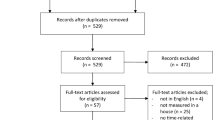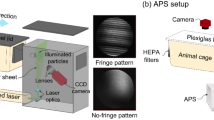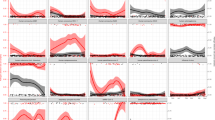Abstract
Airborne mouse allergen is a risk factor for respiratory diseases. Conventional assessment techniques provide mass-based exposure estimates that may not capture completely the inhalation risk of airborne allergen particles. In contrast to mass-based estimates, the halogen immunoassay (HIA) combines immunoblotting and microscopy to directly assess allergen-containing particles. We evaluated the HIA for the assessment of airborne mouse allergen and compared the results to the enzyme linked immunosorbent assay (ELISA). Particulate matter (PM)10 and PM2.5 samples (30 min, 4 l/m) were collected in a mouse facility before, during, and after disturbance of soiled bedding. Concentrations of Mus m 1-positive particles (haloed particles (HPs)) and intensities of the haloes were determined with the HIA. Although HPs/m3 were positively correlated with mass concentration (statistically significant only with Mus m 1 concentration on PM10), replicates of mass concentration showed higher variability than HPs/m3. After disturbance, most of the HPs were in the PM2.5 fraction. Mean haloes intensities were similar before, during, and after disturbance. The HIA was able to measure allergen-containing particles with less variability than the ELISA, detected the shift of HPs to smaller particles after disturbance, and may suggests similar halo intensity by particles detected during and after disturbance. Our findings suggest that the HIA can be used to assess indoor concentrations of mouse allergen particles and their morphological characteristics.
This is a preview of subscription content, access via your institution
Access options
Subscribe to this journal
Receive 6 print issues and online access
$259.00 per year
only $43.17 per issue
Buy this article
- Purchase on Springer Link
- Instant access to full article PDF
Prices may be subject to local taxes which are calculated during checkout



Similar content being viewed by others
References
Matsui E.C., Wood R.A., Rand C., Kanchanaraksa S., Swartz L., and Eggleston P.A. Mouse allergen exposure and mouse skin test sensitivity in suburban, middle-class children with asthma. J Allergy Clin Immunol 2004: 113 (5): 910–915.
Matsui E.C., Simons E., Rand C., Butz A., Buckley T.J., and Breysse P., et al. Airborne mouse allergen in the homes of inner-city children with asthma. J Allergy Clin Immunol 2005: 115 (2): 358–363.
Pacheco K.A., McCammon C., Thorne P.S., O’Neill M.E., Liu A.H., and Martyny J.W., et al. Characterization of endotoxin and mouse allergen exposures in mouse facilities and research laboratories. Ann Occup Hyg 2006: 50 (6): 563–572.
Sheehan W.J., Rangsithienchai P.A., Muilenberg M.L., Rogers C.A., Lane J.P., and Ghaemghami J., et al. Mouse allergens in urban elementary schools and homes of children with asthma. Ann Allergy Asthma Immunol 2009: 102 (2): 125–130.
Nelson H.S. The importance of allergens in the development of asthma and the persistence of symptoms. J Allergy Clin Immunol 2000: 105 (6 Pt 2): S628–S632.
De Lucca S.D., O’Meara T.J., and Tovey E.R. Exposure to mite and cat allergens on a range of clothing items at home and the transfer of cat allergen in the workplace. J Allergy Clin Immunol 2000: 106 (5): 874–879.
O’Meara T.J., De Lucca S., Sporik R., Graham A., and Tovey E. Detection of inhaled cat allergen. Lancet 1998: 351 (9114): 1488–1489.
Chew G.L., Correa J.C., and Perzanowski M.S. Mouse and cockroach allergens in the dust and air in northeastern United States inner-city public high schools. Indoor Air 2005: 15 (4): 228–234.
Hollander A., Gordon S., Renstrom A., Thissen J., Doekes G., and Larsson P.H., et al. Comparison of methods to assess airborne rat and mouse allergen levels. I. Analysis of air samples. Allergy 1999: 54 (2): 142–149.
Platts-Mills T.A.E., and Woodfolk J.A. Allergens and their role in the allergic immune response. Immunol Rev 2011: 242 (1): 51–68.
Casset A., Purohit A., Birba E., Chenard M.P., Uring Lambert B., and Bahram S., et al. Bronchial challenge test in asthmatics sensitized to mites: role of particle size in bronchial response. J Aerosol Med 2007: 20 (4): 509–518.
Poulos L.M., O’Meara T.J., Sporik R., and Tovey E.R. Detection of inhaled Der p 1. Clin Exp Allergy 1999: 29 (9): 1232–1238.
Poulos L.M., O’Meara T.J., Hamilton R.G., and Tovey E.R. Inhaled latex allergen (Hev b 1). J Allergy Clin Immunol 2002: 109 (4): 701–706.
Mitakakis T.Z., Barnes C., and Tovey E.R. Spore germination increases allergen release from Alternaria. J Allergy Clin Immunol 2001: 107 (2): 388–390.
Razmovski V., O’Meara T.J., Taylor D.J., and Tovey E.R. A new method for simultaneous immunodetection and morphologic identification of individual sources of pollen allergens. J Allergy Clin Immunol 2000: 105 (4): 725–731.
Green B.J., Sercombe J.K., and Tovey E.R. Fungal fragments and undocumented conidia function as new aeroallergen sources. J Allergy Clin Immunol 2005: 115 (5): 1043–1048.
Rivera-Mariani F.E., Nazario-Jimenez S., Lopez-Malpica F., and Bolanos-Rosero B. Sensitization to airborne ascospores, basidiospores, and fungal fragments in allergic rhinitis and asthmatic subjects in san juan, puerto rico. Int Arch Allergy Immunol 2011: 155 (4): 322–334.
De Lucca S.D., Taylor D.J., O’Meara T.J., Jones A.S., and Tovey E.R. Measurement and characterization of cockroach allergens detected during normal domestic activity. J Allergy Clin Immunol 1999: 104 (3 Pt 1): 672–680.
Matter C.o.R.P.f.A.P., and Council N.R. Research Priorities for Airborne Particulate Matter: IV. Continuing Research Progress. The National Academies Press: Washington, DC, 2004.
Green B.J., Mitakakis T.Z., and Tovey E.R. Allergen detection from 11 fungal species before and after germination. J Allergy Clin Immunol 2003: 111 (2): 285–289.
Tovey E.R., Taylor D.J.M., Graham A.H., O’Meara T.J., Lovborg U., and Jones A.S., et al. New immunodiagnostic system. Aerobiologia 2000: 16: 113–118.
Adhikari A., Martuzevicius D., Reponen T., Grinshpun S.A., Cho S.H., and Sivasubramani S.K., et al. Performance of the Button Personal Inhalable Sampler for the measurement of outdoor aeroallergens. Atmospheric Environ 2003: 37 (34): 4723–4733.
Ferrari E., Tsay A., Eggleston P.A., Spisni A., and Chapman M.D. Environmental detection of mouse allergen by means of immunoassay for recombinant Mus m 1. J Allergy Clin Immunol 2004: 114 (2): 341–346.
Korpi A., Mantyjarvi R., Rautiainen J., Kaliste E., Kalliokoski P., and Renstrom A., et al. Detection of mouse and rat urinary aeroallergens with an improved ELISA. J Allergy Clin Immunol 2004: 113 (4): 677–682.
Curtin-Brosnan J., Paigen B., Hagberg K.A., Langley S., O’Neil E.A., and Krevans M., et al. Occupational mouse allergen exposure among non-mouse handlers. J Occup Environ Hyg 2010: 7 (12): 726–734.
Hollander A., Van Run P., Spithoven J., Heederik D., and Doekes G. Exposure of laboratory animal workers to airborne rat and mouse urinary allergens. Clin Exp Allergy 1997: 27 (6): 617–626.
Hollander A., Heederik D., Doekes G., and Kromhout H. Determinants of airborne rat and mouse urinary allergen exposure. Scand J Work Environ Health 1998: 24 (3): 228–235.
Jones R.B., Kacergis J.B., MacDonald M.R., McKnight F.T., Turner W.A., and Ohman J.L., et al. The effect of relative humidity on mouse allergen levels in an environmentally controlled mouse facility. Am Ind Hyg Assoc J 1995: 56 (4): 398–401.
Peng R.D., Paigen B., Eggleston P.A., Hagberg K.A., Krevans M., and Curtin-Brosnan J., et al. Both the variability and level of mouse allergen exposure influence the phenotype of the immune response in workers at a mouse facility. J Allergy Clin Immunol 2011: 128 (2): 390–396 e397.
Wood R.A. Laboratory animal allergens. ILAR J 2001: 42 (1): 12–16.
Custovic A., Green R., Fletcher A., Smith A., Pickering C.A., and Chapman M.D., et al. Aerodynamic properties of the major dog allergen Can f 1: distribution in homes, concentration, and particle size of allergen in the air. Am J Respir Crit Care Med 1997: 155 (1): 94–98.
Luczynska C.M., Li Y., Chapman M.D., and Platts-Mills T.A. Airborne concentrations and particle size distribution of allergen derived from domestic cats (Felis domesticus). Measurements using cascade impactor, liquid impinger, and a two-site monoclonal antibody assay for Fel d I. Am Rev Respir Dis 1990: 141 (2): 361–367.
Ohman Jr J.L., Hagberg K., MacDonald M.R., Jones Jr R.R., Paigen B.J., and Kacergis J.B. Distribution of airborne mouse allergen in a major mouse breeding facility. J Allergy Clin Immunol 1994: 94 (5): 810–817.
Platts-Mills T.A., Heymann P.W., Longbottom J.L., and Wilkins S.R. Airborne allergens associated with asthma: particle sizes carrying dust mite and rat allergens measured with a cascade impactor. J Allergy Clin Immunol 1986: 77 (6): 850–857.
Tovey E., Lucca S.D., Poulos L., and O’Meara T. The Halogen assay—a new technique for measuring airborne allergen. In: Jones M.G., and Lympany P. (eds.). Allergy Methods and Protocols. Humana Press: Totowa, NJ, 2008: 138: 227–246.
Acknowledgements
We are very grateful to Dr. Alan Scot and his graduate students of the Department of Microbiology and Molecular Immunology at the Johns Hopkins School of Public Health for granting access to the microscope facility. Also, we would like to acknowledge Dr. Euan Tovey, Research Leader at the Woolcock Institute of Medical Research (Sidney, Australia), for his generosity in providing the adhesive to fix the membranes, and the Dr. Matsui's staff for performing the ELISA analysis and allowing access to the mouse facility. This research was supported by NIESH (T32 ES O7141-28, PO1 ES 018176, P50 ES 015903), U.S. EPA (RD8345101).
Author information
Authors and Affiliations
Corresponding author
Ethics declarations
Competing interests
The authors declare no conflict of interest.
Rights and permissions
About this article
Cite this article
Rivera-Mariani, F., Matsui, E. & Breysse, P. Performance of the halogen immunoassay to assess airborne mouse allergen-containing particles in a laboratory animal facility. J Expo Sci Environ Epidemiol 24, 3–8 (2014). https://doi.org/10.1038/jes.2012.76
Received:
Accepted:
Published:
Issue Date:
DOI: https://doi.org/10.1038/jes.2012.76
Keywords
This article is cited by
-
Exposure science in an age of rapidly changing climate: challenges and opportunities
Journal of Exposure Science & Environmental Epidemiology (2016)



